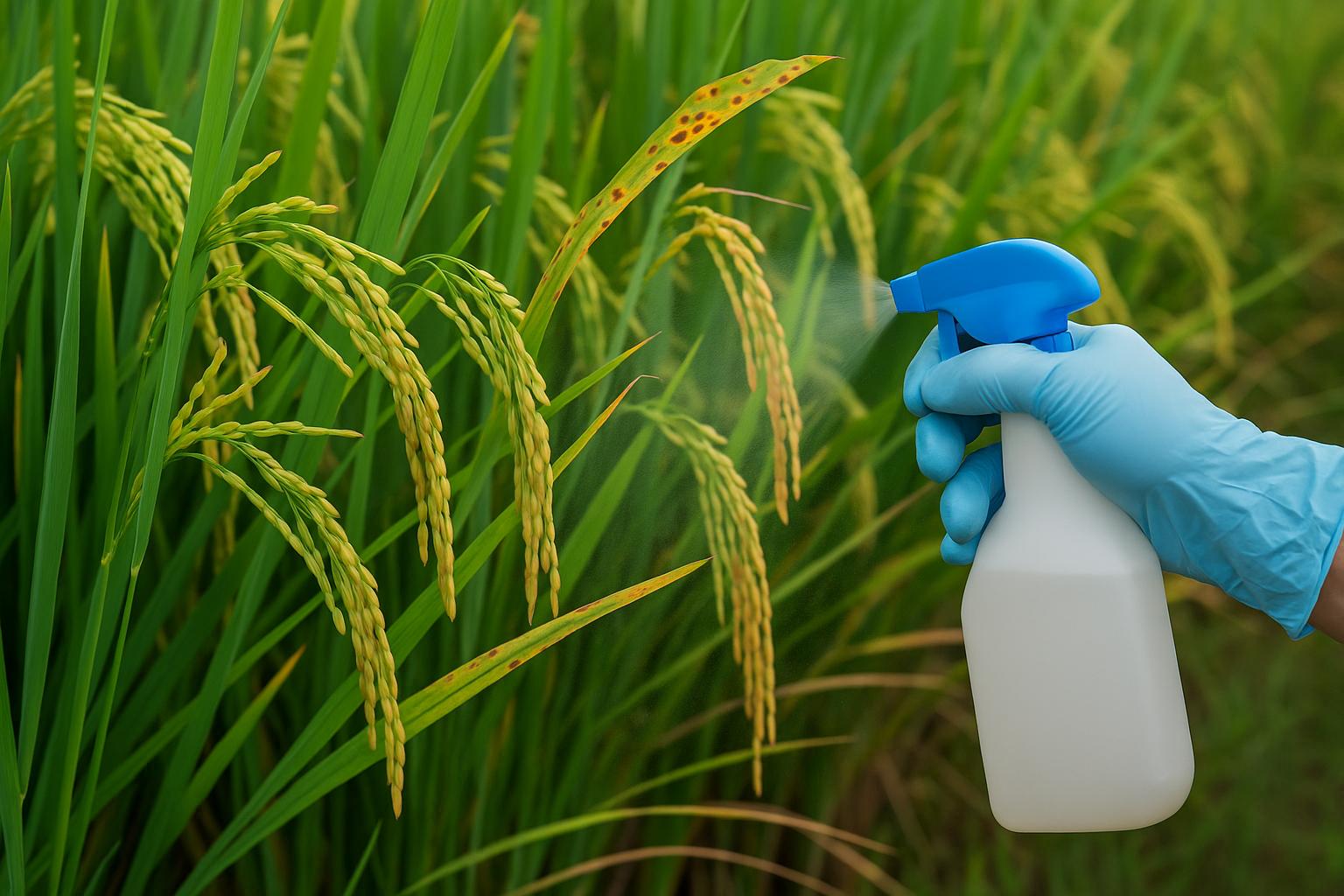Rice feeds more than half the global population, yet fungal diseases continue to threaten its yield and quality. As farming practices evolve, the shift towards systemic fungicides marks a critical advancement in effective rice disease control.
Why Traditional Fungicides Fall Short in Rice Farming
Contact protection is the main benefit of traditional fungicides. Only treated regions are shielded by their coating of plant surfaces. They are frequently washed away by irrigation or rain, which lowers their effectiveness.
Sheath blight and blast are examples of fungal diseases that spread quickly. Farmers must repeatedly apply treatments because contact fungicides are ineffective once infections have penetrated plant tissues. Costs rise, and environmental issues are brought to the forefront.
How Systemic Fungicides Transform Rice Disease Control
Systemic fungicides move through the plant’s vascular tissues. They protect both treated and untreated parts by circulating within the plant. This systemic action gives several advantages:.
- They offer both preventive and curative control of fungal infections.
- They extend protection duration, reducing the frequency of sprays.
These benefits make systemic fungicides indispensable for modern rice farming, especially in unpredictable weather conditions that accelerate disease spread.
What Makes Systemic Fungicides Like Pulsor Effective?
Pulsor contains thifluzamide, a member of the SDHI (succinate dehydrogenase inhibitor) class. SDHIs disrupt fungal respiration by blocking the succinate dehydrogenase enzyme. This inhibition starves fungal cells of energy, stopping their growth.
Key attributes of Pulsor include:
- Strong systemic movement within plant tissues.
- High residual activity for prolonged protection.
- Effective control of Rhizoctonia solani, the sheath blight pathogen.
Sheath blight can reduce rice yields by up to 50% when uncontrolled. Pulsor offers both preventive and curative action, filling a critical gap in rice disease management.
Pulsor’s Role in Integrated Disease Management (IDM)
Integrated Disease Management combines biological, cultural, and chemical tools. Systemic fungicides like Pulsor support IDM by reducing dependency on frequent chemical applications.
The registered formulation, Pulsor Thifluzamide 24% SC Fungicide, provides systemic control of sheath blight with extended residual protection, making it a valuable asset in sustainable disease management strategies.
How Systemic Fungicides Help Manage Fungicide Resistance
Repeated use of single-mode fungicides accelerates the development of resistance in fungal populations. Systemic fungicides, such as Pulsor, help slow the emergence of resistance due to their targeted action.
Agronomists advise rotating SDHI fungicides with other groups like QoIs or triazoles. Combining them with resistant rice varieties and sound field practices boosts long-term effectiveness.
The Economic Value of Systemic Fungicide Use in Rice
Rice diseases cause multi-billion-dollar losses annually. Sheath blight alone contributes to a 6-10% global yield loss. The benefits of systemic fungicide use include:
- Reduced need for frequent applications lowers input and labor costs.
- Higher yields and better grain quality improve farm profitability.
For rice farmers, effective systemic disease control secures income and supports food security.
Scientific Research Underlines Systemic Fungicide Effectiveness
A study in the Journal of Plant Pathology reported over 60% reduction in sheath blight severity with SDHI systemic fungicides like thifluzamide. Additionally, treated crops showed increased grain weight and improved health.
Research in Frontiers in Plant Science confirmed thifluzamide’s systemic movement within rice, protecting new leaves that emerged post-application.
“Agriculture is the most healthful, most useful, and most noble employment of man.” – George Washington
How Systemic Fungicides Work Within Rice Plants
Systemic fungicides enter through leaves or roots and move via the xylem, protecting upper plant parts. They shield new growth that contact fungicides fail to reach, ensuring continuous protection during key stages like tillering and panicle initiation.
Thifluzamide’s systemic behavior is particularly suited for rice paddies, where dense canopy and high humidity elevate disease risk.
Environmental Benefits of Systemic Fungicides
Fewer applications reduce chemical runoff into nearby water bodies. This lowers environmental impact while maintaining crop protection.
Systemic fungicides align with sustainable agriculture goals by striking a balance between productivity and ecological responsibility.
Field Results Showcase Systemic Fungicides’ Impact in Asia
In Andhra Pradesh, India, farm trials recorded a 35% yield increase when Pulsor was integrated into sheath blight control programs. Farmers observed stronger plant vigor and lower disease incidence than with standard treatments.
In Vietnam’s Mekong Delta, the use of systemic fungicides minimized crop losses during the humid seasons, thereby securing vital food supplies.
Global Market Trends Favor Systemic Fungicides
The global fungicide market is projected to hit USD 24.5 billion by 2027. Systemic fungicides drive this growth due to their effectiveness and longevity in crop protection.
Their role in tackling fungicide-resistant strains positions them as a reliable choice for future farming needs.
Climate Change Raises the Stakes for Systemic Fungicides
Unpredictable weather patterns increase the risk of fungal diseases. Warm temperatures and excess rainfall fuel outbreaks of sheath blight and blast. Systemic fungicides provide reliable protection in such variable conditions.
Adopting resilient solutions, such as Pulsor, is crucial for safeguarding rice production in a changing climate.
Best Practices for Using Systemic Fungicides
- Follow label guidelines on application timing and dosage.
- Rotate systemic fungicides with different action modes to curb resistance.
Agricultural experts stress combining systemic products with resistant varieties and good farming practices for optimal results.
Systemic Fungicides and Sustainable Farming Goals
Systemic fungicides maximize disease control while reducing chemical inputs, which contributes to sustainable farming. Their usefulness is increased by their interoperability with contemporary precision farming techniques.
Drone technology, for example, makes it possible to apply systemic fungicides precisely, increasing productivity and decreasing waste.
Regulatory Support for Responsible Fungicide Use
In integrated pest control systems, international organizations promote the prudent use of fungicides. Regulatory support is given to systemic fungicides that satisfy safety and environmental requirements.
Systemic fungicide use is frequently highlighted in certification processes as a component of sustainable farming practices.
Valuable External Resources on Systemic Fungicides
- CropLife International offers information on safe pesticide use and resistance management.
- The Journal of Agricultural and Food Chemistry publishes scientific findings on fungicide efficacy and safety.
What’s Next for Systemic Fungicide Technology?
Future developments could mitigate environmental concerns, enhance rainfastness, and improve systemic mobility. Research on environmentally friendly carriers and nanoformulations is ongoing.
The goal of these advancements is to increase the effectiveness and environmental friendliness of systemic fungicides.
Digital Tools Support Better Fungicide Application
Remote sensing and disease modeling software are examples of data-driven agricultural techniques that help maximize the timing of fungicide applications. These tools increase cost effectiveness and cut down on pointless applications.
By connecting digital farming platforms with systemic fungicide application, farmers can use more intelligent crop protection techniques.
Frequently Asked Questions About Systemic Fungicides
- What are systemic fungicides?
They are chemicals absorbed by plants, providing internal protection against fungal infections before and after onset. - How are systemic fungicides different from contact fungicides?
Systemic fungicides move within the plant, safeguarding both treated and new growth, while contact fungicides only protect sprayed surfaces. - Can systemic fungicides prevent sheath blight?
Yes, they effectively prevent and manage sheath blight, especially when applied early in the infection cycle. - Is regular use of systemic fungicides safe?
Yes, when applied following guidelines and rotated with other fungicide groups to manage resistance. - Where can I learn more about rice disease management?
The International Rice Research Institute provides research, guidelines, and resources on rice health and disease control.
The Future of Rice Farming With Systemic Fungicides
The issues facing rice production are growing, ranging from increased disease pressures to climate change. A proactive protection that gives farmers flexibility and resilience is provided by systemic fungicides.
Systemic fungicides like Pulsor continue to be essential for managing rice diseases in an efficient and sustainable manner even as farming methods change.



